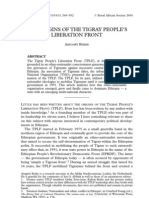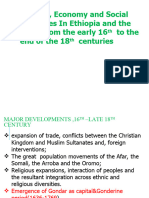Gondar Period
Gondar Period
Uploaded by
yonassheleme1122Copyright:
Available Formats
Gondar Period
Gondar Period
Uploaded by
yonassheleme1122Original Description:
Copyright
Available Formats
Share this document
Did you find this document useful?
Is this content inappropriate?
Copyright:
Available Formats
Gondar Period
Gondar Period
Uploaded by
yonassheleme1122Copyright:
Available Formats
1 Gondar Period
Gondar became the capital of the Ethiopian empire when emperor Fasiladas decided to move to it in
1636. Gondar remained the capital of the Ethiopian empire for the next two centuries. Gondar
possessed a route to the exotic regions south of the Blue Nile and to the then northern and western
trade routes, which led to Massawa and Sudan. Gondar had by 1630 become the catalyst of growth and
production in Ethiopia. It was a great religious center and flourished immensely in the arts. (Pankhurst,
R. 1998, 109)
Emperors of Gondar were great palace and church builders. The most famous of the Gondar palaces was
built by emperor Fasiladas, known as Fasil Gemb. Ensuing rulers continued to build palaces, which still
stand to the day. (Pankhurst, R. 1998, 109-110) Gondar rulers also built many churches i88 1998, 117)
The influence of the Gondar monarchy began to weaken at the dawn of the 18th century. Military
campaigns to crush provincial opponents became less effective and acquiring additional firearms more
difficult. Within Gondar, many did not like the increasing number of Oromos in government. (Pankhurst,
R. 1998, 126-7) In 1757, the city was occupied by Ras Mikael Sehul of Tigray. When he had taken the
city, Emperor Iyoas was an infant. Ras Mikael himself had no intention of becoming emperor but he was
the real leader of Gondar during the time he occupied it. In 1769, which marks the end of what is known
as the Gondar Period in Ethiopian history, Ras Mikael had Iyoas killed and another noble appointed
emperor. From there upon, the Ethiopian empire fell into a time of disunity. Even though emperors
continued to be chosen and sat in Gondar, their power was virtually nonexistent. Each region of the
country became ruled by local governors. (Pankhurst, R. 1998, 128-130).
2 Zamana Masafent or Era of the Princesa
The Era of the Princes, also called Zamana Masafent, was a brief period of history in Ethiopia that lasted
from 1769 to 1855. By 1708, the central government was destroyed and the country had split up into
three different provinces: Amhara, Shoa, and Tigray. The Amhara region was continually in internal
faction and contributed poorly to defending Ethiopia against external enemies. Tigray, on the other had,
played a major role in reinstating an imperial government and hosted a decisive battle at Adwa. On the
other had, Shoa, for the most part, stayed out of the political situations that dealt with the Amhara and
Tigray regions. However, Shoan kings did expand their territories southwards and established trade that
produce an abundance of coffee and slaves. Ethiopia survived this era in its history because of Tigray
and Shoa’s gaining steady power.
Most of Africa was not yet a colonial hotspot at this time. Ethiopia’s biggest foe was Egypt. Egypt had
freed itself from Ottoman control and was now pursuing to expand southwards. The Egyptians attacked
and seized lands in northern Tigray but French and British intervenes helped diminish Egypt’s attempts
to expand south.
Europeans gained even more interest in Ethiopia for the duration of this period. Trade rejuvenated and
tribal lords gained more access to firearms. In the north, Tigraen rulers were able to get hold of guns
from the Turks by means of two-way transactions and used them to seize power. Europeans of many
trades and profession visited the kingdom with more regularity. Missionaries sponsored by the Swiss,
German, and English governments attempted to convert Ethiopians to protestantism. Most of the
missionaries were met with dismayed attitudes and they, more often then not, fell in awkward positions
with civilians and the church. Most Ethiopian rulers were more concerned with the prospective support
and firearms the country would receive rather than the missionaries’ religious endeavors. The
missionaries’ attempts failed but they did bring about awareness of the potential of technological
advancement.
List of Rulers of the Zamana Masafent
1769 Yohannes II
1769 Takla Haymanot II
1769-79 Solomon II
1779-84 Tekle Giyorgis
1784-88 Iyasu III
1788-89 Tekle Giyorgis
1789-94 Hezakeyas
1795 Tekla Giyorgis
1795 Baeda Maryam II
1796-97 Solomon III
1797-98 Yonas
1799 Solomon III
1799 Tekla Giyorgis
1799-1800 Demetros
1800 Tekle Giyorgis
1801 Demetros
1801-18 Egwala Tseyon
1818-21 Iyoas II
1821-26 Gigar
1826 Baeda Maryam III
1826-30 Gigar
1830-32 Iyasu IV
1832 Gabra Krestos
1832-40 Sahela Dengel
1840-41 Yohannes III
1841-55 Sahela Dengel
You might also like
- AssignmentDocument6 pagesAssignmenteskedar assefa0% (1)
- The Origins of TPLFDocument24 pagesThe Origins of TPLFe86% (7)
- A History of Modern Ethiopia, 1855–1991From EverandA History of Modern Ethiopia, 1855–1991Rating: 4.5 out of 5 stars4.5/5 (3)
- Unit Six: The Christian Kingdom and Peoples and States in The Rest of Ethiopian Region and The Horn (1543-1855)Document13 pagesUnit Six: The Christian Kingdom and Peoples and States in The Rest of Ethiopian Region and The Horn (1543-1855)Yabetse Girma75% (4)
- A Summary of Ethiopian HistoryDocument13 pagesA Summary of Ethiopian HistoryGech DebNo ratings yet
- HITORY WORK SHEET Gade 9Document18 pagesHITORY WORK SHEET Gade 9Dawit BerheNo ratings yet
- Chapter 5 & 6Document41 pagesChapter 5 & 6AYNETU TEREFENo ratings yet
- Chapter SixDocument28 pagesChapter SixDemeke DanaNo ratings yet
- The Gondrian PeriodDocument6 pagesThe Gondrian PeriodwabdushukurNo ratings yet
- Zemene Mesafent 1Document12 pagesZemene Mesafent 1hosanagirmay0No ratings yet
- History Through Flags: Flag of Ethiopia: Oldest Tri-Colour in Continuous UseDocument4 pagesHistory Through Flags: Flag of Ethiopia: Oldest Tri-Colour in Continuous UsenahombeNo ratings yet
- Ethiopian History (Territoriak and Economic)Document6 pagesEthiopian History (Territoriak and Economic)eyob astatkeNo ratings yet
- The Zemene MesafintDocument7 pagesThe Zemene Mesafintkidusyosef581No ratings yet
- The Gonderian Period and Zemene MesafintDocument11 pagesThe Gonderian Period and Zemene Mesafintautisticuserr100% (4)
- Zemene MesafintDocument15 pagesZemene Mesafintjuliarthur2280% (5)
- Chapter 6 HistoryDocument31 pagesChapter 6 HistoryKirubel Mulugeta100% (5)
- CC 5Document65 pagesCC 5Abdisa KebedeNo ratings yet
- Chapter SixDocument46 pagesChapter Sixfarxaanyuusuf996No ratings yet
- Gonderian PeriodDocument16 pagesGonderian PeriodGossaNo ratings yet
- Michigan State University Press Northeast African StudiesDocument25 pagesMichigan State University Press Northeast African StudiesAbenezer SamuelNo ratings yet
- History 4th Handout 4 and Worksheet 4 For 11Document6 pagesHistory 4th Handout 4 and Worksheet 4 For 11abrehamNo ratings yet
- History For DummiesDocument8 pagesHistory For DummiesNuralayn NurNo ratings yet
- MimisobajugurupDocument5 pagesMimisobajugurupSAMI ZNo ratings yet
- History Extra PDFDocument13 pagesHistory Extra PDFblenNo ratings yet
- Gonder Period and Zemne MesafintDocument10 pagesGonder Period and Zemne MesafintYoftahe AlemuNo ratings yet
- Internal Developments and External Relations of Ethiopia and The Horn, 1800-1941Document73 pagesInternal Developments and External Relations of Ethiopia and The Horn, 1800-1941Yoftahe Alemu100% (1)
- History GR 9Document11 pagesHistory GR 9ahmedhallo88No ratings yet
- History Chapter FourDocument12 pagesHistory Chapter FourBereketNo ratings yet
- Unit 6Document39 pagesUnit 6Rebuma BekeleNo ratings yet
- Unit Six: The Christian Kingdom and Peoples and States in The Rest of Ethiopian Region and The Horn (1543-1855)Document15 pagesUnit Six: The Christian Kingdom and Peoples and States in The Rest of Ethiopian Region and The Horn (1543-1855)Yabetse Girma100% (1)
- Comment On Melbaa Gadaas Book On The History of Oromo PeopleDocument19 pagesComment On Melbaa Gadaas Book On The History of Oromo PeopleDure H Dasu100% (1)
- HistoryDocument4 pagesHistoryAbrham MengistuNo ratings yet
- Emperor Theodore II and The Kingdom of Shoa 1855-1865Document12 pagesEmperor Theodore II and The Kingdom of Shoa 1855-1865The Ethiopian AffairNo ratings yet
- Compare The Contribution of Theodor and Johannes IV To The Unity and Modernization of EthiopiaDocument4 pagesCompare The Contribution of Theodor and Johannes IV To The Unity and Modernization of EthiopiaTapiwa SatoNo ratings yet
- Unit 5 Hist PPT Hist of Eth and The HornDocument63 pagesUnit 5 Hist PPT Hist of Eth and The Horneteshome923100% (4)
- The Nature of Interactions Among Peoples and States of Ethiopia and The HornDocument15 pagesThe Nature of Interactions Among Peoples and States of Ethiopia and The Hornmesfin teshomeNo ratings yet
- Grade 11 HistoryDocument3 pagesGrade 11 Historygech95465195No ratings yet
- Political Program of EPLF 1977Document20 pagesPolitical Program of EPLF 1977ኣማኑኤል ገብረመስቀልNo ratings yet
- Book HistoryGrade12 (2) - 1-1Document51 pagesBook HistoryGrade12 (2) - 1-1adonaydereje04No ratings yet
- History AssignmentDocument2 pagesHistory Assignmenttesfayeseid7No ratings yet
- Unit 6 History of EHDocument31 pagesUnit 6 History of EHyddiyashiferawNo ratings yet
- Aksum, Also Spelled Axum, Powerful Kingdom in NorthernDocument2 pagesAksum, Also Spelled Axum, Powerful Kingdom in NorthernMas YudaNo ratings yet
- Short Note / Prepared By: 1. Solomon Tarko 9299/19 2. Ermias W/amanuel 6450/19Document59 pagesShort Note / Prepared By: 1. Solomon Tarko 9299/19 2. Ermias W/amanuel 6450/19ERMIAS AmanuelNo ratings yet
- History of Ethiopia & The Horn Unit 5Document57 pagesHistory of Ethiopia & The Horn Unit 5lelizabet662No ratings yet
- History of Ethiopia & The Horn Unit 5Document57 pagesHistory of Ethiopia & The Horn Unit 5Suraphel BirhaneNo ratings yet
- Unit SixDocument59 pagesUnit SixlemmademewakeneNo ratings yet
- Battle in Africa 1879-1914Document50 pagesBattle in Africa 1879-1914Franck Yeghicheyan100% (3)
- The Formation of Modern Ethiopian State and Its Contradictory InterpretationsDocument14 pagesThe Formation of Modern Ethiopian State and Its Contradictory InterpretationsENIYEW EYASUNo ratings yet
- Egyptian CivilizationDocument24 pagesEgyptian Civilizationrosemelynbugto1No ratings yet
- ETFPDDocument73 pagesETFPDBruk AmareNo ratings yet
- History CH 4Document25 pagesHistory CH 4Ermias Atalay100% (12)
- The Making of Modern Ethiopian State Assignment AdmasDocument8 pagesThe Making of Modern Ethiopian State Assignment AdmasEyob Astatke100% (4)
- A Tale of Three EmpiresDocument27 pagesA Tale of Three EmpiresSandeep BadoniNo ratings yet
- Regional DevelopmentsDocument3 pagesRegional DevelopmentsAngelo Otañes GasatanNo ratings yet
- History 4Document2 pagesHistory 4Yitbarek getuNo ratings yet
- 12 - Chapter 3 PDFDocument33 pages12 - Chapter 3 PDFBizu AtnafuNo ratings yet
- Unit-3 (BT)Document7 pagesUnit-3 (BT)Amanuel AyalewNo ratings yet
- History of Ethiopia & The Horn Unit 6Document34 pagesHistory of Ethiopia & The Horn Unit 6metsihetfkade68No ratings yet



























































